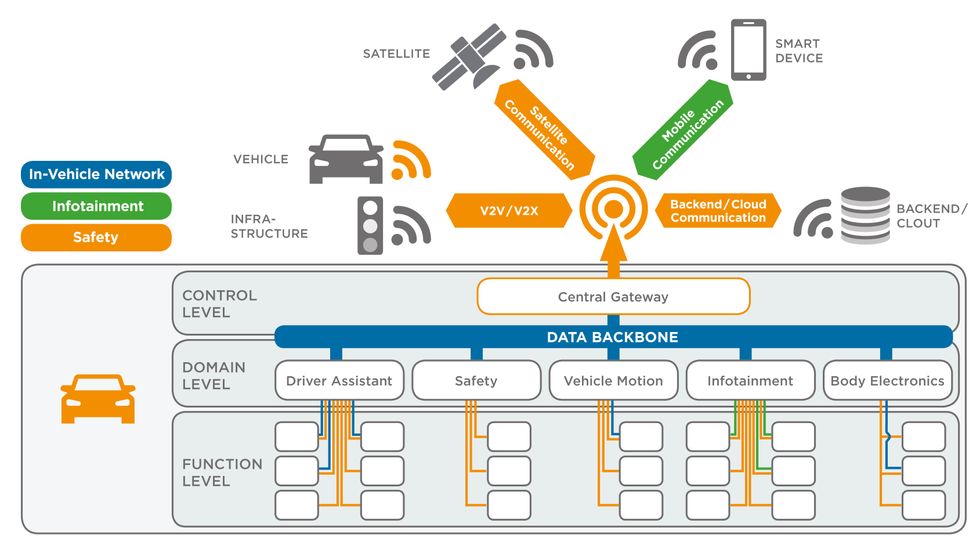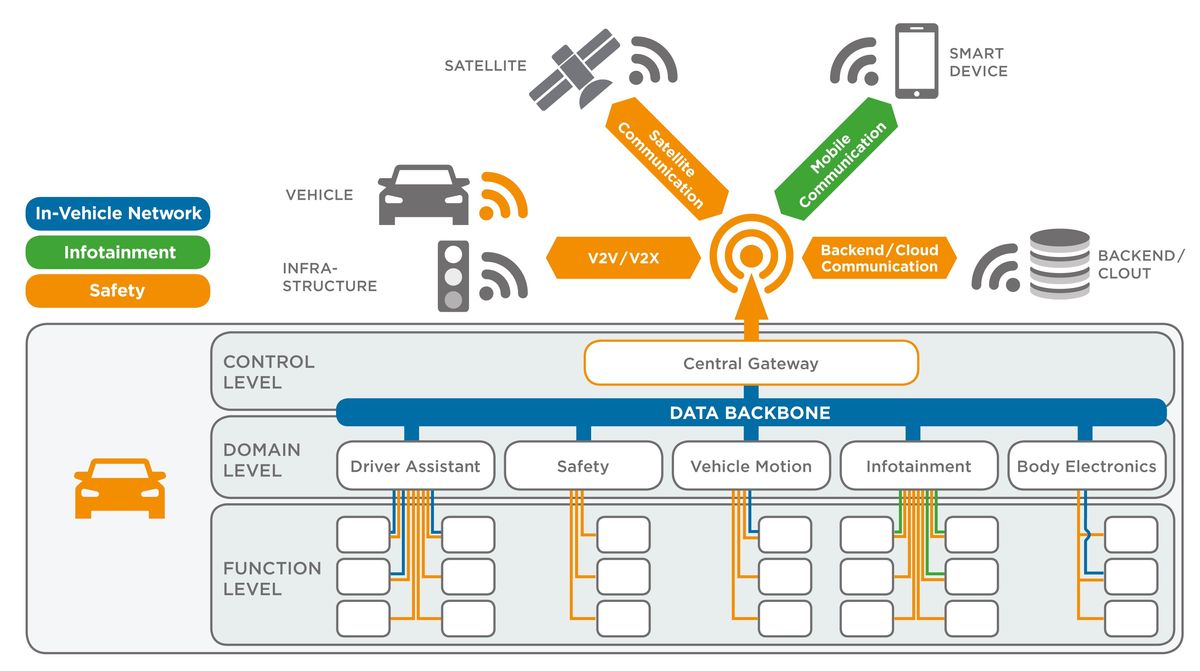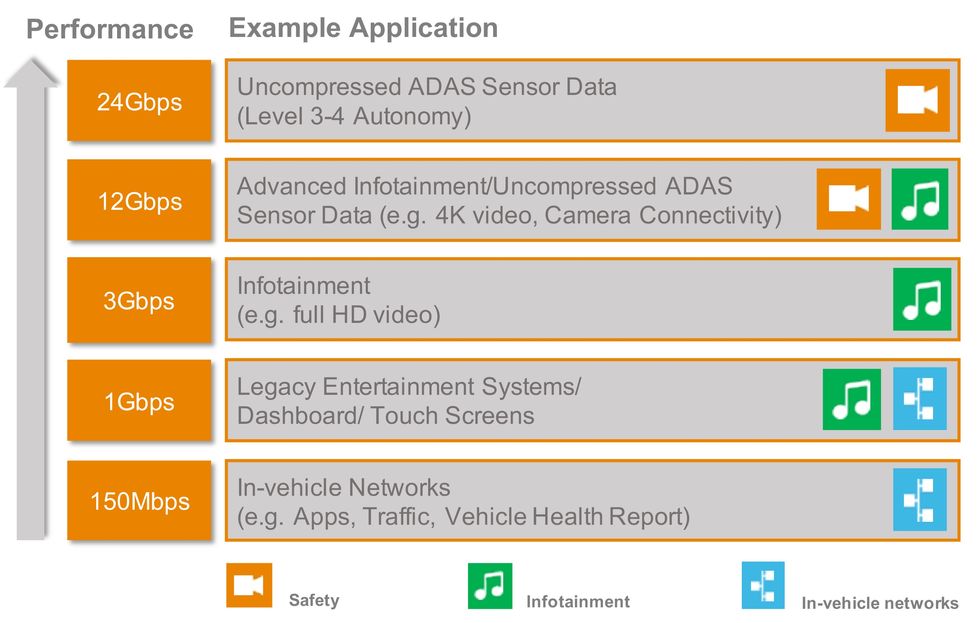Autonomous driving is both an audacious visionary goal and a highly achievable feat of technical engineering. The race to launching the industry’s first fully autonomous car is accelerating, as technology companies like Apple and Waymo battle car companies Audi, Ford, Tesla, Renault, Waymo and ride sharing companies Lyft and Uber to overcome technical challenges and enable an entirely new way of driving that will surprise and delight users.
Who will win the race? And how will driverless cars transform society? While the future of the automotive industry is still unwritten, here is what we know: Industry leaders will need to master connectivity to deliver the V2X (vehicle-to-everything) capabilities fully autonomous driving promises. Here’s an overview of six key connectivity requirements to make that happen.
- Architectures Must Be Redundant and Real-time
Autonomous driving will increasingly demand more and more reliable network-based structures, requiring redundant, real-time architectures. These architectures will organize high performance clusters in functional domains and be connected via a central gateway in a high-speed data backbone structure. Group sensors and actuators will be organized hierarchically.

- The Demand for High-Speed Data Will Only Increase
Driverless cars will have incredibly sophisticated systems, including high performance computers and an increasing number of advanced driver assistance system (ADAS) sensors, such as high-resolution stereo and/or mono cameras, RADAR, and LIDAR, as well as future human-machine interfaces (HMIs), such as large 4K/8K screens or head-up displays (HUDs).
These systems will generate vast amounts of data, which will require sophisticated electronic support, including high-speed data nodes, links, cables, and assemblies. The inside of the driverless car will literally be an information highway, and data streams will run in parallel or different directions. They’ll be managed in switched networks with sufficient margin to ensure the car’s safe operations.
Car manufacturers will be required to continuously increase bandwidths for both point-to-point data pipes and distributed network structures to meet new data demands. Level 5 cars will send 25 gigabytes of data to the cloud every hour.
TE Connectivity (TE) has developed gigabit-speed networks that enable global automotive OEMs to meet these connectivity requirements. TE helps automotive leaders achieve their goals, by providing connectivity solutions that overcome myriad mechanical, electrical, and software protocol and interface compatibility challenges.
- Safety and Other Applications Require External Connectivity
V2X communications must continuously capture and interpret complete data concerning the surrounding environment. Fully autonomous vehicles require all of this information to correctly execute actions such as braking or accelerating without driver assistance.
V2X communications uses both sensor technology and radio-based communication. Car sensors help vehicle systems interact with their immediate surroundings. Radio systems enable vehicles to exchange information with other vehicles and with traffic infrastructure such as lights, signs and tolls. These surroundings actively communicate their state and changing conditions around them to the vehicle. Thus, a light communicates that it is about to change from red to green, a sign indicates that the next turn-off is five miles ahead, and a vehicle a lane over communicates that it is about to signal and turn right. All of these signals make driving safer. Information on driving conditions, such as icy roads ahead, traffic slowdowns, or tolls, can also enable vehicles to interpret data and make automated decisions, such as choosing another route.
Drivers make decisions in split-seconds, and fully autonomous cars will, too. To be safe, fully autonomous driving requires real-time data transmission. Current cellular radio standards such as LTE has a latency of 30 to 40 milliseconds, making it unsafe for driverless vehicles. 5G mobile communication, which will be available for deployment in 2019, will provide higher data rates of up to 10 Gbps with considerably lower latency than LTE, making it suitable for real-time safety applications.
- Autonomous Driving Quality and Reliability Are Non-Negotiable
In addition to being real-time, data sensing and transmission must be 100% reliable. What this means is that connectivity can’t fail because of bad road conditions, such as fog, snow, or ice, or extended use, such as thousands and thousands of hours of operation.
Vehicle manufacturers can achieve this goal by using highly robust automotive-grade connectivity systems, provided by competent and experienced suppliers with engineering and materials science expertise. OEMs’ preferred suppliers must understand contact physics and the best materials for sound electromechanical connections and have built up the exacting manufacturing processes and tools to build them.
- Increasingly Electrified Cars Will Require a New Approach to Safety
Ensuring data integrity within functional safety applications is mandatory for autonomous driving, because human lives will depend on it. As data requirements grow, cars will increasingly electrify. Thus, it is essential to ensure safe data transport on the physical layer level and provide the highest possible physical and data security protections.
Automotive companies are investigating where and when they can use optical-fiber based connectivity to avoid electromagnetic interference. Fiber optic communications do not experience electro-magnetic emissions, crosstalk, or signal distortion. This means optical communication network channels can be placed near high-power electric cables and devices and provide reliable functioning without safety concerns or interference worries.
Suppliers are also developing in-vehicle networks based on global automotive Ethernet standards which would carry encrypted data, rather than using proprietary and legacy networks where the data is vulnerable and un-encrypted. Adopting these standards would help prevent cars from being hacked and remotely controlled by a malicious actor.
- Next-Generation Car Design Will Require Miniaturized Solutions
To fit V2X systems under the hood of a car, manufacturers will need to develop automotive-grade miniaturized and highly integrated connectivity solutions. Sensors and actuators are getting smaller as links increase.
The Automotive Ethernet enables manufacturers to deliver both power and data over a single pair of wires, either shielded or unshielded. TE Connectivity has significant experience in confirming the clearance and creepage margins necessary to accomplish this objective.
At the same time, manufacturers will need to determine and meet pollution and moisture tolerances for systems. In-vehicle networks will need the lightest and leanest cable assemblies and connectors made yet – which will be placed in ever denser configurations. TE is helping the automotive industry make these trade-offs and optimize their solutions, to make data traverse systems faster and in the most power-efficient way, but with less total material connector and cabling material.
Co-creating the Future of Mobility
Autonomous driving is changing the way we view vehicles and mobility. Next-generation cars will not just enable transportation: They will also enhance passenger safety, comfort, and entertainment. Imagine reclining in your car as you drive, holding videoconference meetings, sending emails, and finishing a project before you ever arrive at work.
Today, transportation is a necessary, but often painful process. With fully autonomous driving, passengers will be freed to accomplish their own goals, turning the dead hours of driving into fruitful hours of learning, working, engaging, and relaxing.
TE is at the forefront of fully autonomous driving innovation. For decades, we have teamed with automotive manufacturers to collaborate on connectivity solutions that set new industry standards. Today, we continue to collaborate with our customers to adopt the new standards and technology innovations and provide the connectivity that will power a new generation of cars.
TE provides a robust, comprehensive automotive data connectivity product portfolio with solutions that meet manufacturers’ requirements for function, safety, link type, chips, and cable type, as well as industry standards and OEM or Tier1 specifications. Plastic fiber optic solutions include MOST Connectors, which carry data at speeds up to 150Mbps, and a next-generation solution, which will enable data rates of 10 to 24 Gbps.
To learn more, please visit https://www.te.com/global-en/industries/automotive/insights/connected-car-2.html
TE Connectivity, TE and TE connectivity (logo) are trademarks owned or licensed by TE Connectivity.
Product and / or company names mentioned herein might be trademarks of their respective owners.
MOST is a trademark.
TE Connectivity is a global industrial technology company developing electrical and electronic products engineered to reliably connect and protect the flow of data, power, and signal. TE products and solutions are used in electric vehicles and aircraft, digital factories, smart homes, life-saving medical devices, efficient utility networks, and the global communications infrastructure. Headquartered in Schaffhausen, Switzerland, TE has more than 85,000 employees, including 8,000 engineers, working alongside customers in approximately 140 countries.




